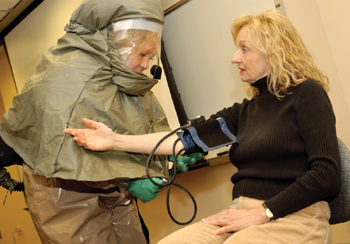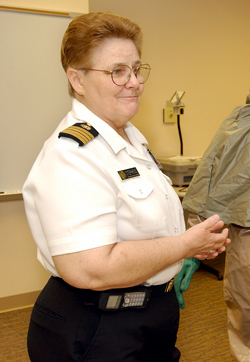
Emily Durbin, a student in the Vanderbilt School of Nursing, attempts to take Nancy Donelson’s blood pressure while wearing personal protection equipment. (photos by Dana Johnson)
Homeland Security instructor trains Vanderbilt nursing students

Veronica Stephens, M.S.N., director of Operations for Science and Technology Directorate in the Department of Homeland Security, leads the course in Emergency Response Management.
Nursing students were suiting up in personal protection equipment last week, led by a guest from the Department of Homeland Security. Fortunately, it was all part of a three-day course in Emergency Response Management and not a real-life disaster.
Captain Veronica Stephens, M.S.N., director of Operations for Science and Technology Directorate in the Department of Homeland Security, was on hand from Washington, D.C. to teach the course to health care providers and other professionals interested in learning how to carry out nurse responsibilities in disaster preparedness and response.
Stephens says unfortunately she can see a day when health care workers will have to put training like this to work in an actual disaster. “There is no place in this country that is completely safe from terrorist activity. Hitting here in the breadbasket is almost more appealing to terrorists, because it can make an even bigger impact, and Tennessee is not exempt from that threat. I think the day is coming,” Stephens said.
The course gave students a chance to try on the cumbersome Personal Protection Equipment suits, commonly called PPE’s.
Susan Johnson, safety officer in Environmental Health, brought the PPE suits for students to practice wearing from the Medical Center, where she says about 100 people working in the Emergency Department have already received PPE training. She agrees that the day will come when medical professionals will be forced to call upon practice and simulation wearing the protective suits.
“If I didn’t, we wouldn’t be doing the training. Somebody’s got to be there to provide triage care,” Johnson said.
Stephens says learning how to maneuver in the suits is extremely difficult. “You have a decreased field of vision and sensatory capabilities. Most doctors and nurses find it almost impossible to function in the gear. Everybody should practice with it at some point,” said Stephens.
Second-year Health Systems Management (HSM) student Emily Durbin tried the PPE on for size. “That suit is hot. The biggest thing is that your field of vision is distorted. You’re looking through plastic and you can’t turn your neck, you have to turn your shoulders,” Durbin said. “You really can’t feel anything, so you have gross movements, but no fine movements.”
Fellow second-year HSM student Julie Perry agrees, and says wearing the suit makes it hard to work. “I have small hands and the gloves are so big. You can’t really grasp anything to do your work,” said Perry.
The Emergency Response Course also gave students a chance to tour the Medical Center’s decontamination facility. “I think it’s a pretty sophisticated system. It’s a good use of space,” Stephens said. “But it is quite drafty and it could be very difficult to do things in there.”
It’s the first time Emergency Response Management has been offered at VUSN. Stephens says it’s not something any school of nursing was offering before the events of Sept. 11, 2001, and the incidents that followed involving anthrax scares and deaths.
“Mainly because nursing has been an afterthought at the table for these national events. It’s a wake-up call. Nurses need to be involved in not only treating patients from these events, but in how to respond to and plan for events of mass casualty or disaster,” she said.
Linda Norman, D.S.N., senior associate dean for Academics, says the Emergency Response Management course is the first in a series of three courses that VUSN will offer to better prepare advanced practice nurses to respond to mass casualty events. “It is based on competencies developed by the International Nursing Coalition for Mass Casualty Education,” said Norman.
Stephens’ role with the Homeland Security Department challenged her to start preparing nurses for emergency response. In doing so, she collaborated with Colleen Conway-Welch, Ph.D., dean of the Vanderbilt School of Nursing, to help create the International Nursing Coalition for Mass Casualty Education (INCMCE), housed at VUSN. The coalition consists of organizational representatives of schools of nursing, nursing accrediting bodies, nursing specialty organizations, and governmental agencies like the Department of Homeland Security interested in promoting mass casualty education for nurses. “The collaboration with Capt. Stephens and the Department of Homeland Security assures us of top-quality, cutting-edge, up-to-the-minute information,” said Conway-Welch.
Stephens says the Emergency Response Course at VUSN is one of the first in the nation to be offered for credit. She says it’s only a matter of time before every school of nursing develops a similar course to be offered to all nursing students, and says she sees a day in the near future when a degree in Emergency Response for mass casualties or disasters will be commonplace.













